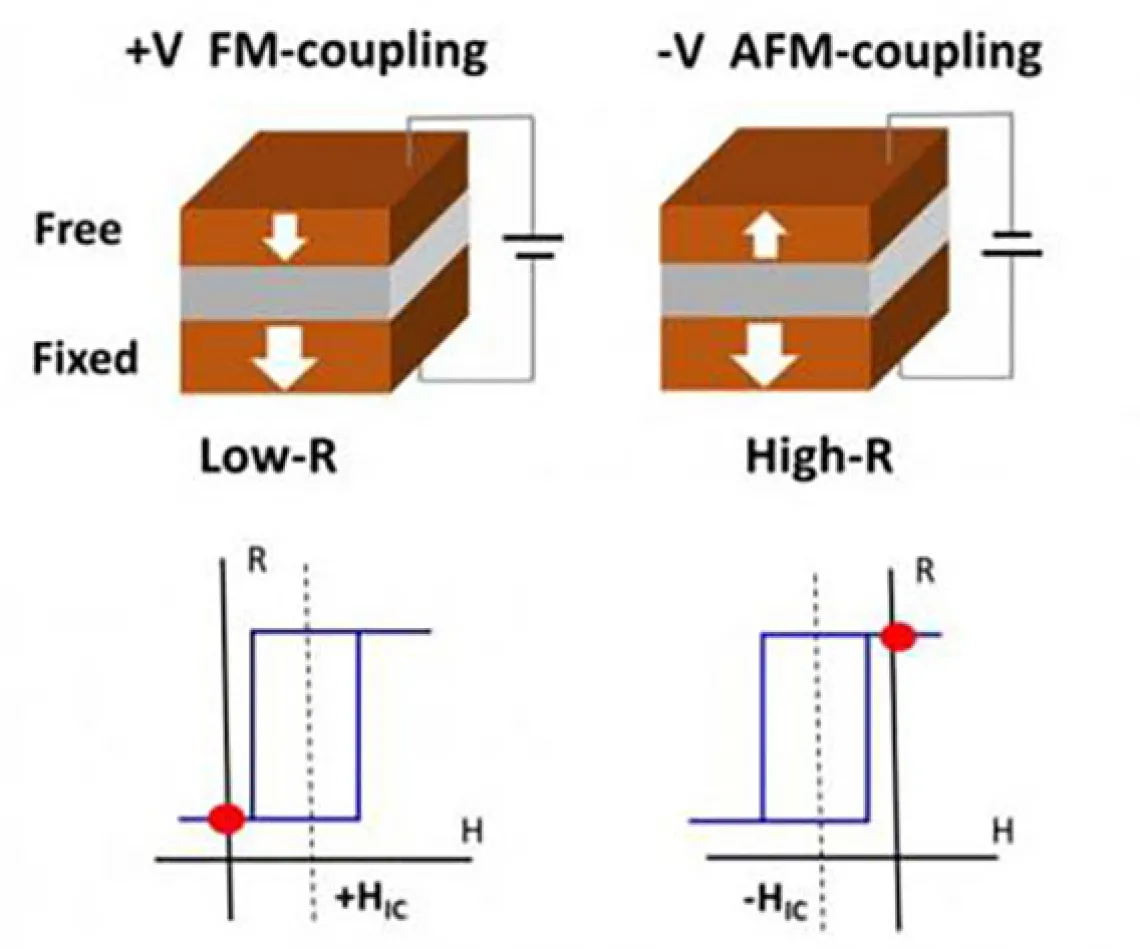First experimental demonstration of voltage-controlled interlayer magnetic coupling
By: Yemille Medina

As the transistors in computers get smaller and denser to allow for more computing power, the energy demands of computing are growing rapidly. Because of their increasingly volatile nature as they scale down in size, transistors become even more power hungry. The future of computing will require a new solution for the storage and processing of data that does not out pace our energy supply. One of the promising candidates for future memory and logic applications is the magnetic tunnel junction (MTJ). An MTJ is a thin film multilayer stack consisting of an ultra-thin insulator (~1 nm) sandwiched by two ferromagnetic layers. Due to spin-polarized quantum mechanical tunneling, the resistance of a MTJ depends on the relative orientation of the magnetizations in the two ferromagnetic layers, exhibiting a low value when the magnetizations are in the parallel configuration and a high value when the magnetizations are in the antiparallel configuration. The difference in resistance could be as large as a few hundred percent at room temperature, when coherent tunneling is obtained with the symmetry-conserved filtering effect in certain structures, making the MTJ a perfect candidate for memory applications. More interestingly, perpendicular magnetization can be reached in some MTJs when the spin-orbit interaction at the ferromagnet/oxide interface overcomes demagnetization field of the ferromagnetic thin films.
While MTJs are non-volatile, reducing the energy for storing data, compared to transistors needing constant data refreshing, they are standardly switched with a magnetic field or a spin-polarized current which requires large amounts of energy. A University of Arizona led team of physicists has demonstrated a way to use voltage to change the state of nano-magnets with perpendicular magnetization in a non-volatile and reversible method paving the way for a new switching method by using voltage to change the coupling between two magnetic layers.
Researchers in Professor Weigang Wang's group and their collaborators have shown that the preferred relative orientation of two magnetic films separated by a unique rare earth oxide, Gd¬Ox, can be reversibly and deterministically changed from parallel to antiparallel with applied voltage. By changing the coupling between the magnetic layers without a magnetic field, this could be used as a mechanism for switching the state of an MTJ with voltage alone. GdO¬x is only the second oxide, MgO being the first, to show the ability to change the state of a perpendicular MTJ with voltage rather than magnetic field or spin current.
This work, first-authored by graduate student Ty Newhouse-Illige, has been published in a recent issue of Nature Communications (http://rdcu.be/r16i.). This research is a collaborative effort among the physics faculty Weigang Wang and Shufeng Zhang, as well as scientists in the Argonne National Lab, Oak Ridge National Lab, University of Minnesota and Bryn Mawr College. The coupling between the magnetic layers is changed when the electric fields modify the oxygenation states of the magnetic layers. Although time scale of the effect is in seconds or tens of seconds in this proof-of-concept study, it is expected that the speed of the voltage controlled interlayer coupling can be greatly increased with further optimization.
The research at the University of Arizona was supported by National Science Foundation and by C-SPIN, one of six centers of STARnet sponsored by SRC and DARPA.



